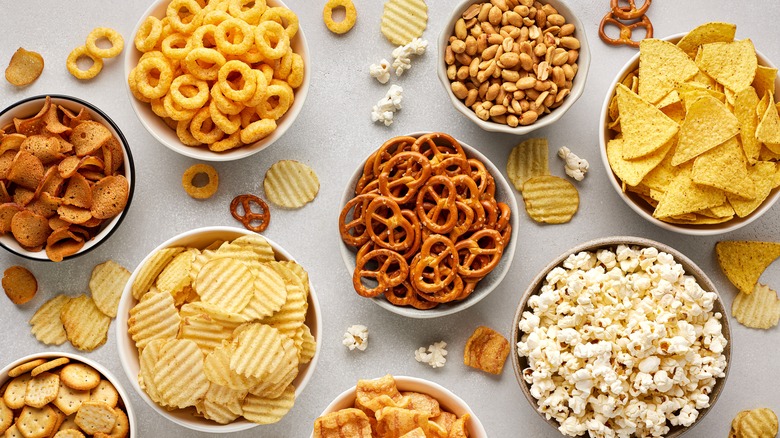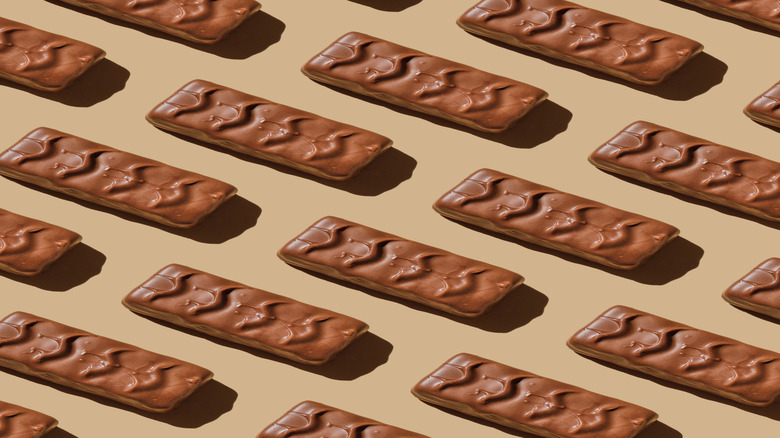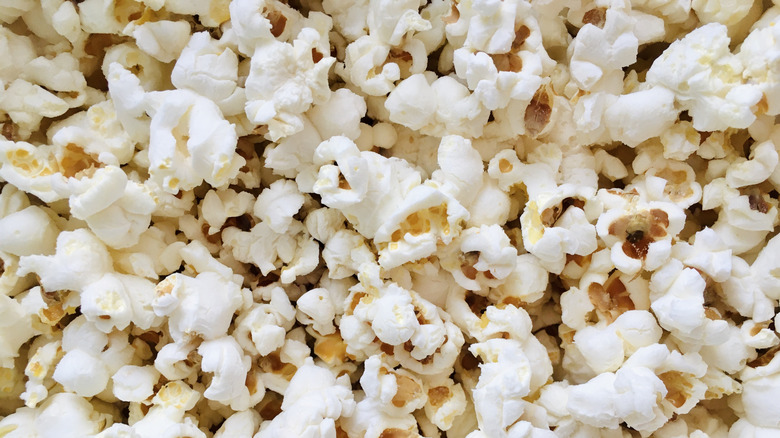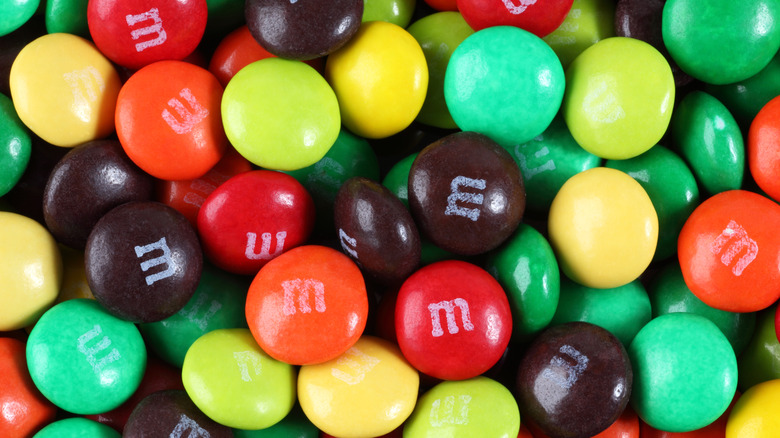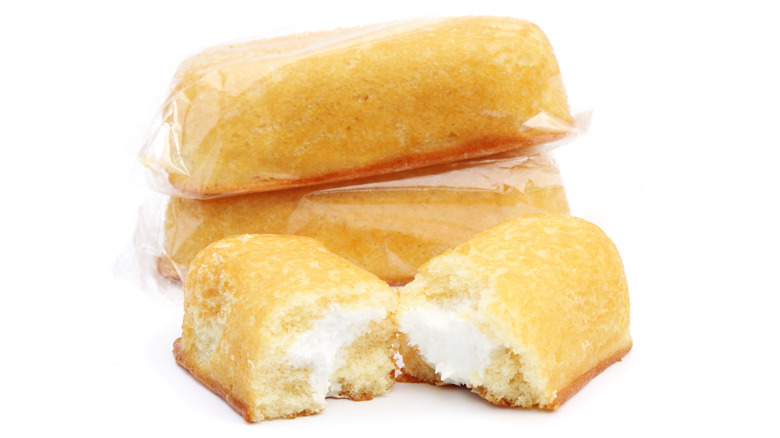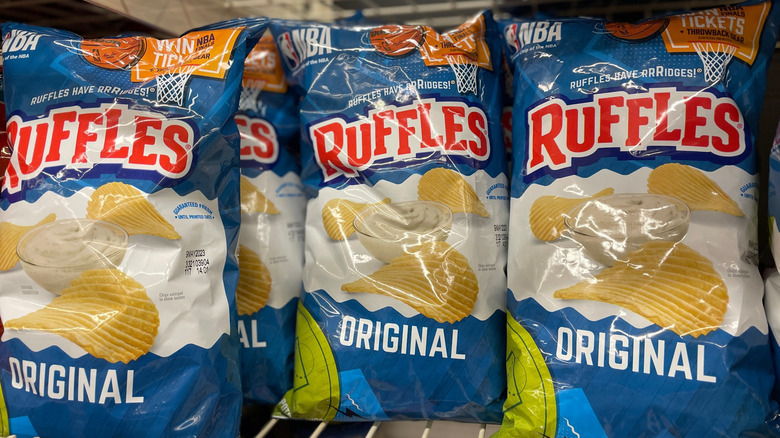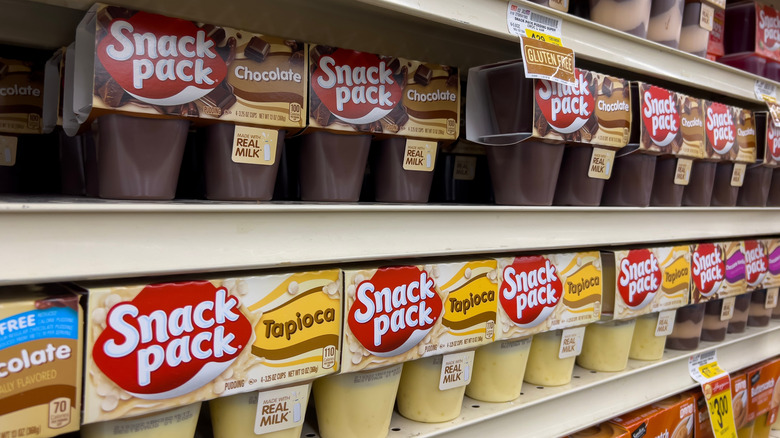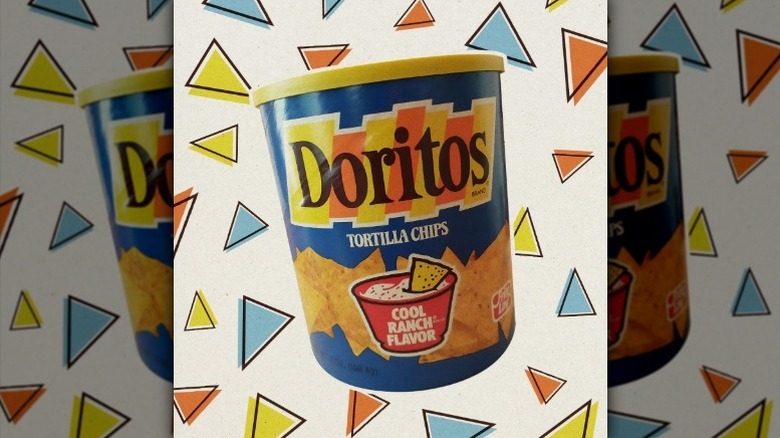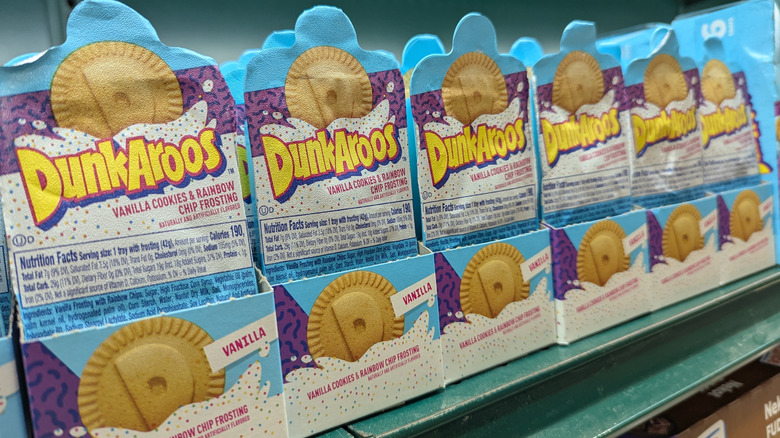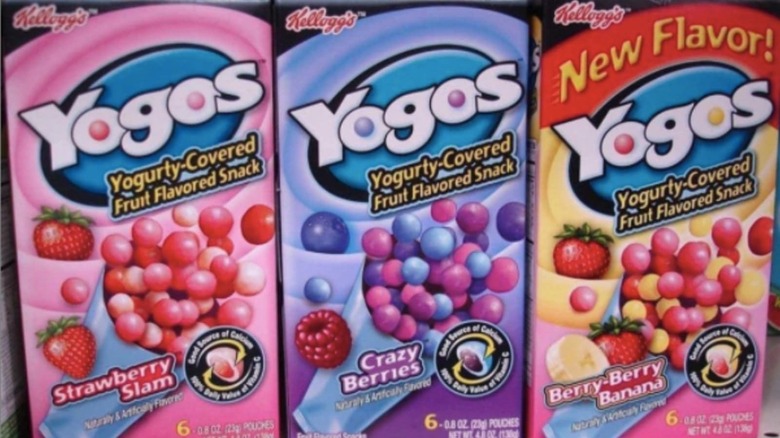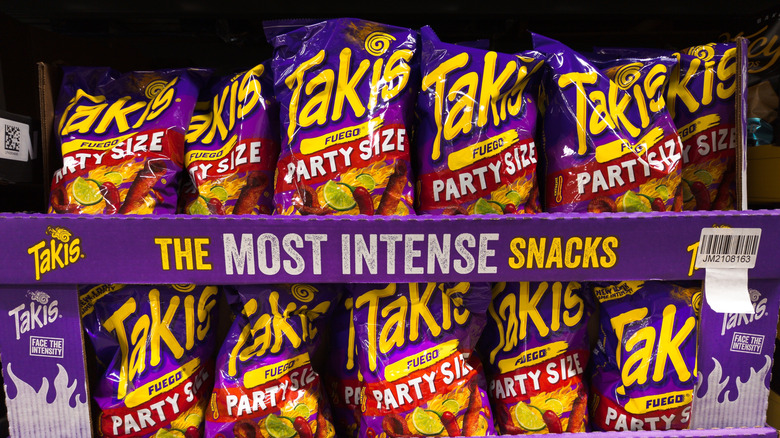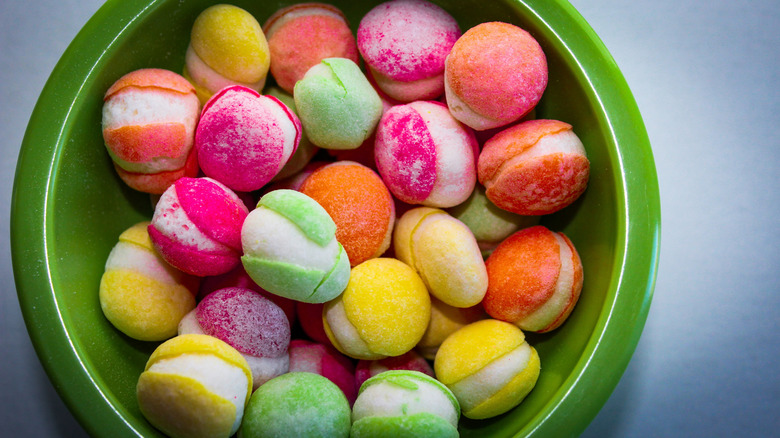The Most Iconic Snacks From Every Decade
Every generation has a signature snack that transports them back to childhood after just one bite. The new trends, flavors, and food technologies of each decade shape how and what was snacked on. From bite-sized convenience to bold flavor experiments, snacks have evolved alongside shifting lifestyles, pop culture moments, and changing ideas of what's considered fun, cool, or even healthy.
It's never just been about filling an empty stomach. Snacking is an experience. A candy bar after school, a bag of popcorn at the movies, or a pack of cookies pulled from a lunch box often carry with them a sense of joy and comfort. The brands we grew up with became characters in their own right, with jingles and mascots that stuck in our memories. Not only are they a part of our individual childhoods, but they've shaped our generational identities.
While some snacks gained popularity in lunch boxes and movie theaters, others entered homes through TV and radio advertisements — more recently, a few have found success on social media. Some were even popularized in the most unexpected ways, by seeing wartime favoritism or being an economical choice during times of financial hardship. And while many have come and gone, a select few leave a lasting impression, earning a permanent place in our collective memory. So, grab your favorite snack and kick your feet up — we're about to unwrap the most iconic snacks from the past century.
1920s: Filled Candy Bars
The 1920s were considered the candy bar boom. During World War I, troops ate candy bars frequently to keep their energy up for battle. After the war, many found themselves craving these sweet treats, and candy makers were ready to fill the demand.
Hershey's was the lead candy maker at the time, and other companies were trying to compete. To do that, they moved away from pure chocolate to try to make something new. That's how the concept of filled candy bars was created. Candy makers were experimenting with all different types of fillings, from sweets like marshmallows to somewhat...interesting choices, like vegetables. While not all succeeded, some of the candy bars we still love today debuted in the '20s. Notable launches included Mounds and Milky Way in 1923 as well as Heath Bars and Reese's Peanut Butter Cups in 1928.
It wasn't just the creativity of the time that made filled candy bars so iconic. It was also the technological advancement that took place. New machinery and the assembly line made it easier to mass-produce candy, making it more accessible and affordable than ever. Candy companies also started heavily marketing their products, utilizing well-written slogans, celebrity endorsements, and a combination of print and radio ads to get the word out. By the end of the decade, filled candy bars were everywhere.
1930s: Popcorn
The '30s were plagued by the Great Depression, and economic hardship made it difficult for families to enjoy luxuries and unnecessary treats. However, going to the movies was one affordable activity that continued to draw crowds during this time. And with that came the iconic snack of the decade: popcorn.
While movies and popcorn are a dynamic duo today, it wasn't always that way. During the '20s, going to the movies was supposed to feel like a luxurious experience, leading theaters to invest in high-end carpets. Unfortunately, popcorn was messy, sticky, and didn't go with the ambiance they were trying to create, so many theaters had banned the food.
When sound was added to movies in the late '20s, it became more accessible for illiterate individuals to enjoy movies. Theaters responded by making the experience more casual and allowing snacks. This was then cemented during the '30s. Popcorn was an affordable treat at only 10 cents a bag, and theaters realized they could make more money by selling the tasty snack themselves. And let's face it — who can resist the urge to buy popcorn when its irresistible smell fills the theater? So, though popcorn was invented over 6,000 years earlier, it will forever be the iconic snack of the 1930s, always synonymous with the movies.
1940s: M&Ms
With their delicate crunch and colorful candy coating, you may be surprised to learn that M&Ms didn't gain recognition in schools or playgrounds at first. They actually gained popularity thanks to the U.S. military. During World War II, the military was looking for easy-to-transport food that would provide energy to troops without melting in the heat. Enter M&Ms. After being available to the general public for just one year, they became exclusive to the military.
In 1947, rations were lifted and many of America's favorite foods were returning to the shelves. When soldiers returned home, they were looking for one snack in particular: M&Ms. And so, the decade's most iconic snack was found.
Of course, M&Ms didn't stop at being an icon of the '40s. They went on to become the first candy in space in 1981. The combination of practicality and deliciousness set them apart from other candies, taking them everywhere from the battlefield to the stars. M&Ms' marketing team also capitalized on these, creating the slogan "Now 100% at War" during World War II to make them seem credible and patriotic and releasing limited-edition space-themed M&Ms to commemorate NASA. M&Ms now remain not only an iconic '40s snack, but also an important part of American history.
1950s: Twinkies
In the 1950s, Twinkies weren't just a snack — they were a cultural phenomenon. They were originally invented in 1933 by James A. Dewar, who worked for a company that made strawberry shortcakes. He noticed that the machines used to make these cakes collected dust when strawberries were out of season, so he proposed using them to make banana filled cakes too. Then, when bananas were rationed during the wartime in the '40s, the center was changed to vanilla cream, which still fills the Twinkie we all know and love today.
While Twinkies were popular in the '30s and '40s, it wasn't until the '50s that they became a true icon. Twinkies sponsored the popular kids' show Howdy Doody, and created advertisements during the show that were aimed at kids and featured Howdy himself. Since Howdy Doody was the first show successful enough to air five days a week on NBC, commercials for Twinkies landed them a prime spot in American homes and in the hearts (and stomachs) of baby boomers.
When Hostess filed for bankruptcy in 2012, Twinkie lovers panicked and started stockpiling their favorite snack. Thankfully, the company was swiftly bought up, and Twinkies (along with other Hostess favorites) returned to stores less than a year later. Sales are still going strong, and it seems like this iconic '50s snack is here to stay.
1960s: Ruffles Chips
Classic potato chips gained popularity in the U.S. in the '20s, but Ruffles hit the scene in the '60s and turned the chip game on its head. Inventor Bernhardt Stahmer found himself experimenting with new chip textures. He believed that his unique cutting method altered the taste of the chip and gave it a cheese-like flavor without adding any flavoring at all.
While his customers didn't necessarily agree that the chips tasted like cheese, they liked them nonetheless. After merging with Frito-Lay in 1958, they really took off. Frito-Lay had the resources and marketing know-how to take Ruffles national.
And it came just in time. Chips and dip became popularized in the '50s, but many light and crispy chips broke too easily to stand up to dip. Ruffles were a sturdier option for thick dips due to their ridges, which has helped them stand apart from the competition and made them perfect for gatherings. They've continued to be popular over the decades, and are now sold internationally. While the crinkle-cut chips may not have delivered the signature cheese flavor Stahmer thought they would, they're now available in a wide array of flavors, including many different cheesy options.
1970s: Snack Pack Pudding
The 1970s introduced a lunchtime game-changer: Snack Pack pudding. Debuting in 1968 in single-serve aluminum cans, this portable dessert quickly became a school-lunchroom essential that stayed firmly in the spotlight throughout the decade. Not only were they easy to pack in lunch boxes, but the cans were durable so kids didn't have to worry about leaks if they bumped their lunch box around.
Cool and creamy, Snack Packs offered a sweet escape in the chaos of school days. Flavors evolved to match the era's tastes and novelty cravings. By 1971, offerings included chocolate, vanilla, lemon, butterscotch, chocolate fudge, and even banana. These choices made each pudding feel like a mini-adventure instead of a mundane part of lunch. The company also came out with applesauce for a healthier option, but it's the pudding cups that became the iconic snack of the decade.
Not only was the pudding delicious, but the packs mirrored the era's growing preference for pre-packaged and portioned food. No longer was pudding a messy shared dish. It was all about personal-size indulgence that could easily be packed into lunch boxes, road trip coolers, or picnic baskets. This portability helped cement their place in family routines, paving the way for other brands (like Swiss Miss) to create similar products.
1980s: Cool Ranch Doritos
By the mid-1980s, Doritos had already made a name for itself with its Nacho Cheese flavor. But in 1986, the brand raised the stakes with a new, unexpected twist: Cool Ranch. At the time, ranch dressing was gaining popularity in America and Doritos cleverly converted that trend into chip form.
Cool Ranch Doritos stood out immediately. Instead of leaning on heat or spice, the flavor delivered something different: a tangy, herby, creamy profile. It felt fresher, more modern, and even a little daring compared to the other salty snacks of the era. It was, well, just plain cool.
What made Cool Ranch such a hit wasn't just the taste, but the timing. The 1980s was a decade of bigger, bolder, flashier everything, and a chip coated in bright, zesty seasoning fit right in. Ranch wasn't yet the top-selling dressing it would become in the '90s, so biting into a Cool Ranch Dorito felt like trying something new and different. The chip's success also helped define Doritos' identity moving forward. The company has continued to push the envelope and create new flavors; in fact, there have been over 100 different flavors of Doritos sold around the world.
1990s: Dunkaroos
In 1992, Dunkaroos burst onto the snack scene as a fun and playful combo. Let's face it, taking small graham crackers and dunking them into a tub of frosting is a genius idea — one that's only made more enticing by the fun and fashionable kangaroo mascot daring you to get as much frosting onto your cookie as you could.
'90s kids agreed, and the snack achieved a near-cult status. Over the years, Dunkaroos released several flavor combos, including chocolate chip cookies with chocolate frosting and cookies n' cream cookies with white crème frosting. The company even did a Shrek collaboration that paired Shrek-shaped cookies with green frosting.
While Dunkaroos were discontinued in the U.S. in 2012, its nostalgic pull remained strong. Dedicated fans in America resorted to using a "Smugglaroos" tactic to get their favorite treat from Canada, where it had not yet been discontinued. Then, in 2020, the beloved snack made an official comeback stateside. General Mills confirmed Dunkaroos would be returning to U.S. shelves in the summer with its iconic vanilla cookies and rainbow sprinkles frosting combo. For many, opening the familiar pack and getting to dunk cookies into icing once again was like stepping back into childhood, further securing its place as an iconic snack.
2000s: Yogos
The 2000s was a golden age for quirky, kid-friendly snack innovations, and few captured that spirit better than Yogos. Introduced by Kellogg's in 2005, Yogos featured bite-sized, fruit-flavored centers coated in a tangy, creamy yogurt shell. But what made them so iconic wasn't just their taste — it was how they fused two of the decade's most dominant snack trends into one tasty treat.
On one side, there were kid-friendly yogurt brands like Go-Gurt, Trix yogurt, and Danimals, which were designed to feel fun while remaining healthy enough for parents to say yes to them. These colorful yogurts exploded in popularity, turning the once-boring yogurt aisle into a rainbow of bold flavors and cartoon mascots. On the other side were gummies. From Scooby-Doo fruit snacks to Bertie Bott's Every Flavor Beans, the snack aisle was full of chewy, fruit-flavored fun. Yogos took both of those ideas and mashed them into one creamy, chewy surprise. It felt inventive and, in the words of another '00s icon, Hannah Montana, it was the best of both worlds.
Though Yogos only lasted a few years before being discontinued in 2010, their impact has stuck around. Over 15,000 people have signed online petitions for their return, but Kellog's has unfortunately not unveiled any plans to do so. So for now, they remain sealed away in our memories as one of the most iconic snacks of the 2000s.
2010s: Takis
In the 2010s, one snack from Mexico loudly blazed through the U.S. market and became an icon of extreme flavor: Takis. What set this snack apart was its bold, fiery taste, particularly the Fuego variety which has a mouth-watering lime and chili pepper flavor. They also boast a unique shape. Unlike other snacks that are light and crisp, Takis' tightly-rolled corn chips deliver maximum crunch.
But how did Takis rise up amidst the stiff competition of Cheetos, Doritos, and the like? Two words: guerilla marketing. While other snacks fought for shelf space in supermarkets, Takis focused on gas stations and convenience stores. Word of the hard-to-resist flavor spread quickly until Takis stood out as one of the most iconic snacks of the decade. Barcel became one of the fastest growing companies in the country, and continually came out with new flavors and textures to keep its customers coming back for more.
Takis' popularity exploded on social media too. Influencers raved about them, consumers found new and unique ways to incorporate them in recipes, and they were even the center of a viral challenge. Overtime, Takis became more than a snack. They became a symbol of a new generation who are bold and adventurous, and who want their snacks that way too.
2020s: Freeze-dried candy
The 2020s have ushered in a new snack sensation: freeze-dried candy. When candy is freeze dried, the moisture is removed, giving the candy a light, crunchy texture that's packed with concentrated flavor. Although this technique was designed for the military, it's found fame among the general population. It gives snackers the ultimate combo: familiar flavors from their favorite candies with a bold new texture. It seems like there is no shortage in the types of candy that can be freeze-dried either. Hard candies, chocolate bars, gummies, and chewy candies have all been part of this new trend.
Beyond the sensory novelty, these treats explode in visual appeal, making them perfect for social media feeds. Influencers spread the word quickly, creating 122 million TikTok posts on freeze-dried candy by mid-2024. Major brands, like Skittles and Jolly Ranchers, have rolled out their own lines, making it easier to find freeze-dried treats in big retailers like Walmart and Target.
Freeze-dried candy also fits perfectly with the 2020s' appetite for nostalgic yet reimagined trends. It combines childhood favorites with cutting-edge food science, giving both Gen Z and Millennials a reason to revisit classic candies in a brand-new way. In a decade driven by aesthetics, novelty, and social sharing, freeze-dried candy hits all the right notes.
